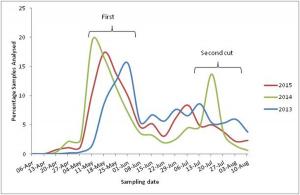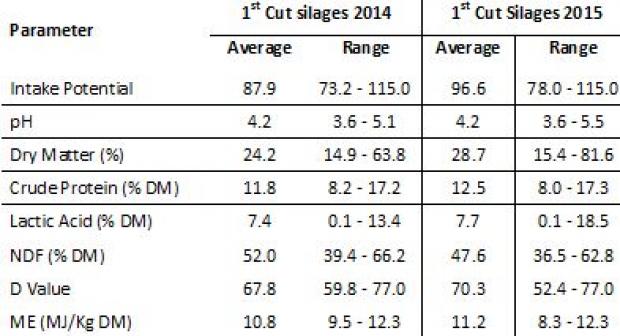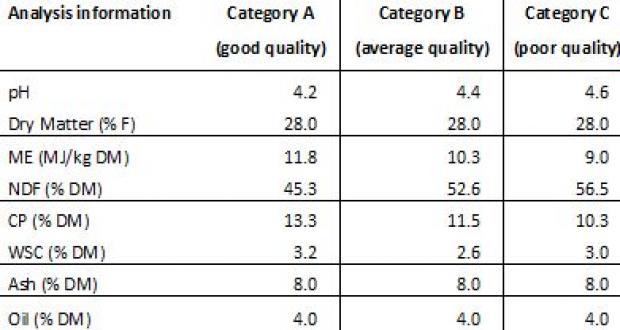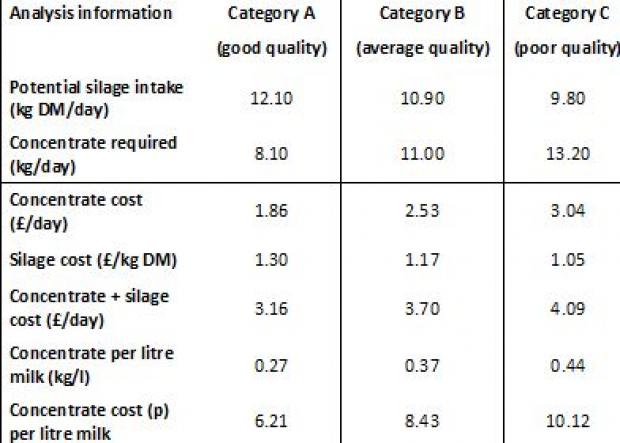Management and feeding of grass silage to maximise animal performance is particularly important this winter when margins are low. It is also essential for farmers who have invested heavily into making silage, to know what its true feeding value really is. Winter diets can then be formulated to maximise silage feeding value, particularly for autumn and winter calving dairy cows were concentrate supplementation adds substantially to production costs.

Research at AFBI Hillsborough has shown that early cutting, leading to highly digestible silage, improves milk yield and quality. However there is cause for concern this year based on the timing distribution of ‘ensilability samples’ received at AFBI Hillsborough (Figure 1). These samples are normally sent about two days before harvesting to confirm that pastures are ready to ensile. The graph shows that in 2015, first cut samples were received nearly two weeks later compared with last year. Poor grass growth during the last week in April and early May this year resulted in many farmers being unable to cut silage during the optimum period, normally 4-10 May, as in 2014. Therefore many first cuts were delayed until 20th May. This was only slightly earlier than 2013, which had an exceptionally cold late spring.
Review of this year's silage results
It is difficult for farmers to evaluate silage quality on farm and expectations could be far from correct. Variable weather conditions during the grass growing period (especially during the summer) disrupted normal silage harvesting patterns and this will have implications for silage quality. The Hillsborough Forage Information Service (HFIS) provides an informative analysis of silage quality that is easily interpreted and at relatively low cost.


The key objective in silage making is to produce a grass-silage with a metabolizable energy (ME) of 11.5-12.0 MJ/Kg DM, a crude protein of 14-16%, dry matter content of 25-30% and with a resultant intake potential 100+. If categories A and C (Table 2) are compared then:
For category A quality silage, dairy cows will consume 9.8 kg of dry matter per day, with an ME of 11.8 MJ/kg DM resulting in an ME intake of 115.6 MJ.
For category C quality silage and the same 9.8Kg of dry matter consumed, but at an ME of 9.0 MJ/kg DM, the animal has only consumed 88.2 MJ of energy.
So the difference for a daily diet between categories A and C is 27.4 MJ of energy, which has to be made up using concentrate feed. This difference is further compounded because the actual intakes of animals offered these two silages will not be the same. For category A the intake potential at 100 is much higher than Category C only 81.
Overall this means that to achieve the same animal performance an increased level of concentrate feeding will be required with category C silage and that brings substantial extra costs. The effect on feed costs for a dairy cow producing 30 litres of milk per day is shown in Table 3, where the higher feeding value of silage A requires 5.1 kg concentrate less per day than silage C. In terms of costs for a 600kg live weight cow and for concentrate at £230/t, this means that an animal on silage A costs 10.53p/litre/day total feed cost of both concentrate and silage, compared to 13.62p/litre/day for silage C – a saving of over 3 pence per litre.

The laboratory service at Hillsborough is accredited to a very high scientific standard (ISO9001 and UKAS 17025) and is the ‘Master Laboratory’ for the forage analytical assurance group (FAA) in the UK and Ireland, having provided farmers with a reliable forage analytical service for many years.
The service is available from AFBI Hillsborough, Co Down (BT26 6DR),
T) +44(0) 2892681 589 / 583 /580, email: agri.analysis@afbini.gov.uk.
Note:
Results refers to a 600kg Holstein dairy cow, producing an average of 30 litres of milk per day during lactation. Concentrate £230.00 per tonne and silage 28% DM with an estimated cost of £30.00 per tonne fresh.
Notes to editors:
AFBI carries out high quality technology research and development, statutory, analytical, and diagnostic testing functions for DARD and other Government departments, public bodies and commercial companies.
AFBI's Vision is “Scientific excellence in Northern Ireland … serving the world”.
All media enquiries to AFBI Press Office.
Latest news
- AFBI issues Nematodirus warning – Spring 2025 11 April 2025
- Managing Nature Based Risks to the UK Economy and Opportunities for Green Finance 08 April 2025
- AFBI Hillsborough host AERA committee 27 March 2025
- The Omics Days Conference 27 March 2025
